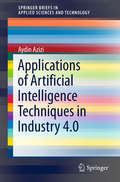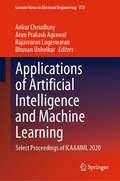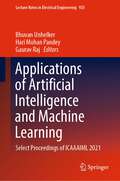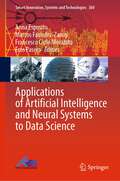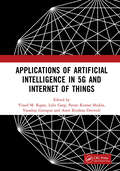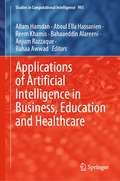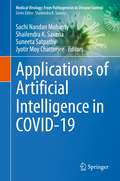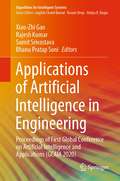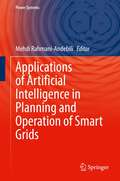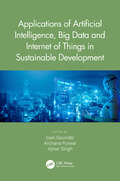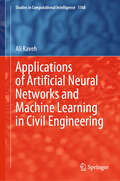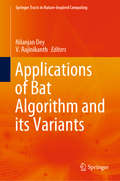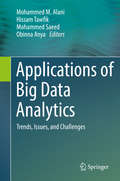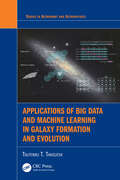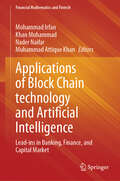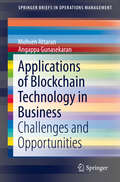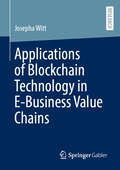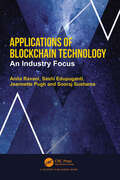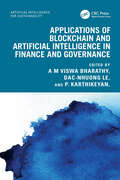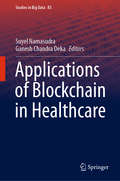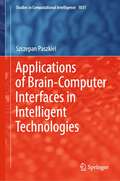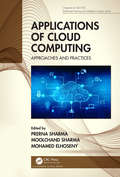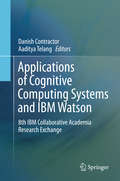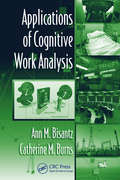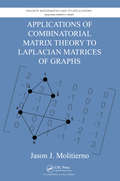- Table View
- List View
Applications of Artificial Intelligence Techniques in Industry 4.0 (SpringerBriefs in Applied Sciences and Technology)
by Aydin AziziThis book is to presents and evaluates a way of modelling and optimizing nonlinear RFID Network Planning (RNP) problems using artificial intelligence techniques. It uses Artificial Neural Network models (ANN) to bind together the computational artificial intelligence algorithm with knowledge representation an efficient artificial intelligence paradigm to model and optimize RFID networks.This effort leads to proposing a novel artificial intelligence algorithm which has been named hybrid artificial intelligence optimization technique to perform optimization of RNP as a hard learning problem. This hybrid optimization technique consists of two different optimization phases. First phase is optimizing RNP by Redundant Antenna Elimination (RAE) algorithm and the second phase which completes RNP optimization process is Ring Probabilistic Logic Neural Networks (RPLNN). The hybrid paradigm is explored using a flexible manufacturing system (FMS) and the results are compared with well-known evolutionary optimization technique namely Genetic Algorithm (GA) to demonstrate the feasibility of the proposed architecture successfully.
Applications of Artificial Intelligence and Machine Learning: Select Proceedings of ICAAAIML 2020 (Lecture Notes in Electrical Engineering #778)
by Bhuvan Unhelkar Ankur Choudhary Arun Prakash Agrawal Rajasvaran LogeswaranThe book presents a collection of peer-reviewed articles from the International Conference on Advances and Applications of Artificial Intelligence and Machine Learning - ICAAAIML 2020. The book covers research in artificial intelligence, machine learning, and deep learning applications in healthcare, agriculture, business, and security. This volume contains research papers from academicians, researchers as well as students. There are also papers on core concepts of computer networks, intelligent system design and deployment, real-time systems, wireless sensor networks, sensors and sensor nodes, software engineering, and image processing. This book will be a valuable resource for students, academics, and practitioners in the industry working on AI applications.
Applications of Artificial Intelligence and Machine Learning: Select Proceedings of ICAAAIML 2021 (Lecture Notes in Electrical Engineering #925)
by Hari Mohan Pandey Bhuvan Unhelker Gaurav RajThe book presents a collection of peer-reviewed articles from the International Conference on Advances and Applications of Artificial Intelligence and Machine Learning—ICAAAIML 2021. The book covers research in the areas of artificial intelligence, machine learning, and deep learning applications in health care, agriculture, business, and security. This book contains research papers from academicians, researchers as well as students. There are also papers on core concepts of computer networks, intelligent system design and deployment, real-time systems, wireless sensor networks, sensors and sensor nodes, software engineering, and image processing. This book is a valuable resource for students, academics, and practitioners in the industry working on AI applications.
Applications of Artificial Intelligence and Neural Systems to Data Science (Smart Innovation, Systems and Technologies #360)
by Anna Esposito Marcos Faundez-Zanuy Francesco Carlo Morabito Eros PaseroThis book provides an overview on the current progresses in artificial intelligence and neural nets in data science. The book is reporting on intelligent algorithms and applications modeling, prediction, and recognition tasks and many other application areas supporting complex multimodal systems to enhance and improve human–machine or human–human interactions. This field is broadly addressed by the scientific communities and has a strong commercial impact since investigates on the theoretical frameworks supporting the implementation of sophisticated computational intelligence tools. Such tools will support multidisciplinary aspects of data mining and data processing characterizing appropriate system reactions to human-machine interactional exchanges in interactive scenarios. The emotional issue has recently gained increasing attention for such complex systems due to its relevance in helping in the most common human tasks (like cognitive processes, perception, learning, communication, and even "rational" decision-making) and therefore improving the quality of life of the end users.
Applications of Artificial Intelligence in 5G and Internet of Things: Proceedings of the 1st International Conference on Applications of AI In 5G And IoT (ICAAI5GI2024), 9–10 August 2024, Greater Noida, India
by Varadraj Gurupur Lalit Garg Vinod M. Kapse Pavan Kumar Shukla Amit Krishna DwivediThis is the proceedings of the 1st International Conference on Applications of AI in 5G and IoT (ICAAI5GI2024). It brings together ground-breaking research and practical insights into integrating Artificial Intelligence within 5G and the Internet of Things (IoT).This compilation highlights the latest advancements and innovative solutions emerging at the intersection of AI, 5G, and IoT technologies. It also delves into a wide array of topics, including the role of AI in enhancing 5G network efficiency, the development of intelligent IoT devices, and the creation of smart environments powered by these cutting-edge technologies. It further showcases key findings on AI-driven applications in 5G for seamless communication, improved connectivity, and advanced data processing techniques, along with IoT solutions for smart cities, industrial automation, healthcare, and beyond.It would be a valuable read for researchers, engineers, and professionals in AI, 5G, IoT, and related fields. It serves as an essential resource for those seeking to stay at the forefront of technological advancements in these rapidly evolving domains.
Applications of Artificial Intelligence in Business, Education and Healthcare (Studies in Computational Intelligence #954)
by Aboul Ella Hassanien Allam Hamdan Anjum Razzaque Bahaaeddin Alareeni Reem Khamis Bahaa AwwadThis book focuses on the implementation of Artificial Intelligence in Business, Education and Healthcare, It includes research articles and expository papers on the applications of Artificial Intelligence on Decision Making, Entrepreneurship, Social Media, Healthcare, Education, Public Sector, FinTech, and RegTech. It also discusses the role of Artificial Intelligence in the current COVID-19 pandemic, in the health sector, education, and others. It also discusses the impact of Artificial Intelligence on decision-making in vital sectors of the economy.
Applications of Artificial Intelligence in COVID-19 (Medical Virology: From Pathogenesis to Disease Control)
by Jyotir Moy Chatterjee Shailendra K. Saxena Suneeta Satpathy Sachi Nandan MohantyThe book examines the role of artificial intelligence during the COVID-19 pandemic, including its application in i) early warnings and alerts, ii) tracking and prediction, iii) data dashboards, iv) diagnosis and prognosis, v) treatments, and cures, and vi) social control. It explores the use of artificial intelligence in the context of population screening and assessing infection risks, and presents mathematical models for epidemic prediction of COVID-19. Furthermore, the book discusses artificial intelligence-mediated diagnosis, and how machine learning can help in the development of drugs to treat the disease. Lastly, it analyzes various artificial intelligence-based models to improve the critical care of COVID-19 patients.
Applications of Artificial Intelligence in Engineering: Proceedings of First Global Conference on Artificial Intelligence and Applications (GCAIA 2020) (Algorithms for Intelligent Systems)
by Xiao-Zhi Gao Rajesh Kumar Sumit Srivastava Bhanu Pratap SoniThis book presents best selected papers presented at the First Global Conference on Artificial Intelligence and Applications (GCAIA 2020), organized by the University of Engineering & Management, Jaipur, India, during 8–10 September 2020. The proceeding will be targeting the current research works in the domain of intelligent systems and artificial intelligence.
Applications of Artificial Intelligence in Planning and Operation of Smart Grids (Power Systems)
by Mehdi Rahmani-AndebiliArtificial intelligence (AI) is going to play a significant role in smart grid planning and operation, especially in solving its real-time problems, as it is fast, adaptive, robust, and less dependent on the system’s accurate model and parameters. This collection covers research advancements in the application of AI in the planning and operation of smart grids. A global group of researchers and scholars present innovative approaches to AI-based smart grid planning and operation, cover the theoretical concepts and experimental results of the application of AI-based techniques, and apply these techniques to deal with smart grid issues. Applications of Artificial Intelligence in Planning and Operation of Smart Grids is an ideal resource for researchers on the theory and application of AI, practicing engineers working in electrical power engineering, and students in advanced graduate-level courses.
Applications of Artificial Intelligence, Big Data and Internet of Things in Sustainable Development
by Sam Goundar Archana Purwar Ajmer SinghThis book focuses on different algorithms and models related to AI, big data and IoT used for various domains. It enables the reader to have a broader and deeper understanding of several perspectives regarding the dynamics, challenges, and opportunities for sustainable development using artificial intelligence, big data and IoT. Applications of Artificial Intelligence, Big Data and Internet of Things (IoT) in Sustainable Development focuses on IT-based advancements in multidisciplinary fields such as healthcare, finance, bioinformatics, industrial automation, and environmental science. The authors discuss the key issues of security, management, and the realization of possible solutions to hurdles in sustainable development. The reader will master basic concepts and deep insights of various algorithms and models for various applications such as healthcare, finance, education, smart cities, smart cars, among others. Finally, the book will also examine the applications and implementation of big data IoT, AI strategies to facilitate the sustainable development goals set by the United Nations by 2030. This book is intended to help researchers, academics, and policymakers to analyze the challenges and future aspects for maintaining sustainable development through IoT, big data, and AI.
Applications of Artificial Neural Networks and Machine Learning in Civil Engineering (Studies in Computational Intelligence #1168)
by Ali KavehThis book provides different applications of artificial neural networks (ANN) and machine learning (ML) in various problems of material science, structural optimization, and optimal analysis of structures in twenty two chapters. Nowadays, the world has witnessed unprecedented advances in technology and computer science. Artificial intelligence has emerged as a top field captivating global attention. Often referred to as AI, this technology stands apart from other disciplines as it aims to design machines and systems that exhibit intelligence, learn autonomously, and make decisions akin to humans. In order to comprehend the impact of this innovation, one must delve into the workings of artificial intelligence, trace its historical evolution from inception to the present day, and explore its diverse applications in domains like medicine, transportation, broadcasting, and marketing. Artificial intelligence introduces a transformative element to our reality, fostering significant breakthroughs and innovations. The book is used in any AI course, in particular, in Civil Engineering. It is also utilized in various fields of Industrial Civil Engineering.
Applications of Bat Algorithm and its Variants (Springer Tracts in Nature-Inspired Computing)
by Nilanjan Dey V. RajinikanthThis book highlights essential concepts in connection with the traditional bat algorithm and its recent variants, as well as its application to find optimal solutions for a variety of real-world engineering and medical problems. Today, swarm intelligence-based meta-heuristic algorithms are extensively being used to address a wide range of real-world optimization problems due to their adaptability and robustness. Developed in 2009, the bat algorithm (BA) is one of the most successful swarm intelligence procedures, and has been used to tackle optimization tasks for more than a decade. The BA’s mathematical model is quite straightforward and easy to understand and enhance, compared to other swarm approaches. Hence, it has attracted the attention of researchers who are working to find optimal solutions in a diverse range of domains, such as N-dimensional numerical optimization, constrained/unconstrained optimization and linear/nonlinear optimization problems. Along with the traditional BA, its enhanced versions are now also being used to solve optimization problems in science, engineering and medical applications around the globe.
Applications of Big Data Analytics: Trends, Issues, and Challenges
by Mohammed M. Alani Hissam Tawfik Mohammed Saeed Obinna AnyaThis timely text/reference reviews the state of the art of big data analytics, with a particular focus on practical applications. An authoritative selection of leading international researchers present detailed analyses of existing trends for storing and analyzing big data, together with valuable insights into the challenges inherent in current approaches and systems. This is further supported by real-world examples drawn from a broad range of application areas, including healthcare, education, and disaster management. The text also covers, typically from an application-oriented perspective, advances in data science in such areas as big data collection, searching, analysis, and knowledge discovery.Topics and features:Discusses a model for data traffic aggregation in 5G cellular networks, and a novel scheme for resource allocation in 5G networks with network slicingExplores methods that use big data in the assessment of flood risks, and apply neural networks techniques to monitor the safety of nuclear power plantsDescribes a system which leverages big data analytics and the Internet of Things in the application of drones to aid victims in disaster scenariosProposes a novel deep learning-based health data analytics application for sleep apnea detection, and a novel pathway for diagnostic models of headache disordersReviews techniques for educational data mining and learning analytics, and introduces a scalable MapReduce graph partitioning approach for high degree verticesPresents a multivariate and dynamic data representation model for the visualization of healthcare data, and big data analytics methods for software reliability assessmentThis practically-focused volume is an invaluable resource for all researchers, academics, data scientists and business professionals involved in the planning, designing, and implementation of big data analytics projects.Dr. Mohammed M. Alani is an Associate Professor in Computer Engineering and currently is the Provost at Al Khawarizmi International College, Abu Dhabi, UAE. Dr. Hissam Tawfik is a Professor of Computer Science in the School of Computing, Creative Technologies & Engineering at Leeds Beckett University, UK. Dr. Mohammed Saeed is a Professor in Computing and currently is the Vice President for Academic Affairs and Research at the University of Modern Sciences, Dubai, UAE. Dr. Obinna Anya is a Research Staff Member at IBM Research – Almaden, San Jose, CA, USA.
Applications of Big Data and Machine Learning in Galaxy Formation and Evolution (Series in Astronomy and Astrophysics)
by Tsutomu T. TakeuchiAs investigations into our Universe become more complex, in-depth, and widespread, galaxy surveys are requiring state-of-the-art data scientific methods to analyze them. This book provides a practical introduction to big data in galaxy formation and evolution, introducing the astrophysical basics, before delving into the latest techniques being introduced to astronomy and astrophysics from data science. This book helps translate the cutting-edge methods into accessible guidance for those without a formal background in computer science. It is an ideal manual for astronomers and astrophysicists, in addition to graduate students and postgraduate students in science and engineering looking to learn how to apply data-science to their research.Key Features: Introduces applications of data-science methods to the exciting subject of galaxy formation and evolution Provides a practical guide to understanding cutting-edge data-scientific methods, as well as classical astrostatistical methods Summarises a vast range of statistical and informatics methods in one volume, with concrete applications to astrophysics
Applications of Block Chain technology and Artificial Intelligence: Lead-ins in Banking, Finance, and Capital Market (Financial Mathematics and Fintech)
by Mohammad Irfan Khan Muhammad Muhammad Attique Khan Nader NaifarToday, emerging technologies offer a new pathway for advancing the economy in the fields of banking, finance, and capital markets. Blockchain applications play a crucial role in ensuring trust and security within these industries by relying on transparency and visibility through peer-to-peer networks. The banking industry has also witnessed increased operations speed, better transparency, efficiency enhancement, fraud extenuation at less cost while sharing real-time data between various parties. Thus, the adoption of blockchain in the Banking and Insurance industry is developing very fast. It has emerged as the commonly accepted default platform for the banking and insurance industry. This book explores how blockchain technology optimizes and integrates transactions and operations, facilitating easier access to information. This, in turn, has the potential to reduce communication costs and minimize minor data transfer errors. Additionally, the book delves into the current applications of blockchain technology in the financial industry, discusses its limitations, and outlines its future prospects for broader accessibility. This book is aimed at students and researchers in financial engineering and fintech and it can serve as a reference for identifying problem areas and their possible solutions.
Applications of Blockchain Technology in Business: Challenges and Opportunities (SpringerBriefs in Operations Management)
by Angappa Gunasekaran Mohsen AttaranThe book discusses the various ways that blockchain technology is changing the future of money, transactions, government, and business. The first two chapters walk through the foundation of blockchain. Chapters 3–12 look at applications of blockchain in different industries and highlight its exciting new business applications. It show why so many companies are implementing blockchain, and present examples of companies who have successfully employed the technology to improve efficiencies and reduce costs. Chapter 13 highlights blockchain’s powerful potential to foster emerging markets and economies including smart cities, value-based healthcare, decentralized sharing economy, machine to machine transactions, data-sharing marketplace, etc. Chapter 14 offers a conceptual model, provides information and insights, and covers a step-by-step approach to plan and develop blockchain-based technology.
Applications of Blockchain Technology in E-Business Value Chains
by Josepha WittBlockchain Technology (BCT) is explored as a substantial part of the next generation of the Internet affecting business models in e-business. This book explores the application of BCT in e-business focusing on the value creation. The research objective is to examine how and why BCT is used in e-business value chains. This objective is reached through a pragmatic multimethod approach combining four studies. Study 1 summarises the state-of-the-art of approaches to assess a BCT fit for a particular scenario and outlines shortcomings resulting from these approaches. Study 2 provides empirical insights into the usage of BCT in four e-business value chains based on the cases Theta (content), OpenBazaar (commerce), Presearch (context), and Crypviser (connection). Study 3 deepens the insights in the e-commerce value chain. By means of a qualitative content analysis of news articles, various BCT application domains for each e-commerce activity are presented. Study 4 narrows the perspective of analysis to e-negotiations, proposes a BC-based negotiation support system and examines its opportunities and challenges. Finally, an integrative discussion of the findings results in two explanations how BCT is applied in e-business.
Applications of Blockchain Technology: An Industry Focus
by Anita Ravani Sashi Edupuganti Jeannette Pugh Sooraj SushamaBlockchain technology is a disruptive technology that affords businesspeople an opportunity to correct problems of dishonesty, corruption, and poor decision-making. This book crafts blockchain technology for the non-technical expert, to interpret the various applications of blockchain technology through the lens of various industries and creates opportunities for professionals using practical applications and case studies. Blockchain technology is an important platform for businesses to consider as it provides a consensus based, trusted, and transparent system for businesses to operate various critical functions. As such, this book is a first of its kind to take a deep dive into the application of blockchain technology in different sectors. Applications of blockchain technology is explored through understanding of implementation and configuring the use of blockchain technology in real business application. The book provides access to disseminate blockchain technology and its application in a clear and structured manner by assimilating real-world-cases by providing valuable information for business audiences for all business sectors.
Applications of Blockchain and Artificial Intelligence in Finance and Governance (Artificial Intelligence for Sustainability)
by Dac-Nhuong Le P. Karthikeyan A M Viswa BharathyIn the rapidly evolving landscape of finance and governance, the integration of blockchain technology and artificial intelligence is reshaping the way we perceive and interact with traditional systems. In Applications of Blockchain and Artificial Intelligence in Finance and Governance, the authors delve into the intricacies of this dynamic intersection, offering a comprehensive exploration of the transformative potential of these cutting-edge technologies. From dissecting the symbiotic relationship between artificial intelligence and blockchain to examining their profound impact on cryptocurrency markets, each chapter offers invaluable insights into the role of these technologies in shaping the future of finance. With a meticulous review of open risks and challenges, the book navigates through the complexities of data security in public and consortium blockchain systems, paving the way for enhanced trust and transparency in financial transactions. Through real-world case studies and theoretical frameworks, readers are guided through the application of intelligent resource allocation for data analytics, unlocking the potential for optimized decision-making in blockchain-enabled financial transactions. Moreover, the book explores the revolutionary implications of blockchain and AI in maintaining smart governance records, revolutionizing accountability and efficiency in public administration.This book: Introduces a step-by-step procedure for developing blockchain and artificial intelligence-based applications for the finance industry using decentralized applications and hyperledgers. Discusses improved trust framework and data integrity in the blockchain using artificial intelligence in the finance sector. Highlights the importance of blockchain in solving transaction costs, coordination costs, and supervision costs for efficient resource allocation. Explores the use of explainable artificial intelligence for policy development, service delivery, and regulatory compliance. Explains how federated learning can be used to build more accurate and robust models for financial risk assessment, fraud detection, and customer profiling. From the transformative effects on the accounting profession to the burgeoning adoption of blockchain technology in supply chain finance, this book serves as an indispensable guide for professionals, academics, and enthusiasts alike. Applications of Blockchain and Artificial Intelligence in Finance and Governance illuminates the path toward a more secure, efficient, and equitable financial future, where innovation and collaboration reign supreme.
Applications of Blockchain in Healthcare (Studies in Big Data #83)
by Ganesh Chandra Deka Suyel NamasudraThis book discusses applications of blockchain in healthcare sector. The security of confidential and sensitive data is of utmost importance in healthcare industry. The introduction of blockchain methods in an effective manner will bring secure transactions in a peer-to-peer network. The book also covers gaps of the current available books/literature available for use cases of Distributed Ledger Technology (DLT) in healthcare. The information and applications discussed in the book are immensely helpful for researchers, database professionals, and practitioners. The book also discusses protocols, standards, and government regulations which are very useful for policymakers.
Applications of Brain-Computer Interfaces in Intelligent Technologies (Studies in Computational Intelligence #1031)
by Szczepan PaszkielThe BCI technology finds newer and newer implementations. Year by year, the number of publications in this field grows exponentially. This book attempts to describe the implementation of the brain-computer technology based on both STM32 and Arduino microcontrollers. In addition, the application of BCI technology in the field of intelligent houses, robotic lines as well as in the field of bionic prostheses was presented. One of the chapters of the monograph also discusses the issue of fMRI in the context of the possibility of analyzing images made as part of fMRI through solutions based on machine learning. A practical implementation of the TensorFlow framework was presented. The fMRI technique is also often implemented in BCI solutions. The conducted literature studies show that the technology of BCI is undoubtedly a technology of the future. However, there is a need for continuous development of biomedical signal processing methods in order to obtain the most efficient implementations in the case of non-invasive implementation of BCI technology based on EEG. The further development of BCI technology has a huge impact on the techniques of rehabilitation of people with disabilities. Nowadays, wheelchairs are being constructed, thanks to which a disabled person is physically able to direct his position in a certain direction and at a certain speed. Thanks to BCI, it is also possible to create an individual speech synthesizer, with the help of which a paralyzed person will be able to communicate with the outside world. New limb prostheses that will replace the lost locomotor system in almost one hundred percent are still being developed. Some prostheses are connected to the human nervous system, thanks to which they are able to send feedback to our brain about the shape, hardness and temperature of the object held in the artificial limb.
Applications of Cloud Computing: Approaches and Practices (Chapman & Hall/CRC Distributed Sensing and Intelligent Systems Series)
by Mohamed Elhoseny Prerna Sharma Moolchand SharmaIn the era of the Internet of Things and with the explosive worldwide growth of electronic data volume, and associated need of processing, analysis, and storage of such a humongous amount of data, it has now become mandatory to exploit the power of massively parallel architecture for fast computation. Cloud computing provides a cheap source of such a computing framework for a large volume of data for real-time applications. It is, therefore, not surprising to see that cloud computing has become a buzzword in the computing fraternity over the last decade. Applications of Cloud Computing: Approaches and Practices lays a good foundation for the core concepts and principles of cloud computing applications, walking the reader through the fundamental ideas with expert ease. The book progresses on the topics in a step-by-step manner. It reinforces theory with a full-fledged pedagogy designed to enhance students' understanding and offer them a practical insight into the applications of it. It is a valuable source of knowledge for researchers, engineers, practitioners, and graduate and doctoral students working in the field of cloud computing. It will also be useful for faculty members of graduate schools and universities.
Applications of Cognitive Computing Systems and IBM Watson: 8th IBM Collaborative Academia Research Exchange
by Danish Contractor Aaditya TelangThis book presents reports and methods that demonstrate the ease with which cognitive applications can be built using IBM Watson application program interfaces (APIs). It includes application reports from two IBM Watson API-based competitions - Hackathon (24 hours) and a Challenge task (~3 months). It also features a selection of papers presented at I-CARE 2016, the IBM Collaborative Academia Research Exchange event, from the areas of "Theory and Cognitive Computing", "Data Platforms and Systems," and "Societal Applications. " IBM has a long tradition of research collaboration with colleagues in academia, and I-CARE is an annual event initiated in 2009 to promote collaborative innovation and learning, and explore new ways of fostering a culture of innovation. I-CARE's main goal is to "amalgamate" the thought leadership in Indian academia with that in industry, and foster a symbiotic environment for establishing a rich research culture in India. The 8th edition of I-CARE presents a collection of thought-provoking ideas and novel Indian research projects related to three crucial areas: cognitive computing, systems and platforms that support large-scale data processing and practical systems that are designed for the public good.
Applications of Cognitive Work Analysis
by Catherine M. Burns Ann M. BisantzDespite continued interest in Cognitive Work Analysis (CWA) techniques for the analysis and design of complex, human-technology systems, few published accounts exist that document all of the five recommended phases of CWA in real world applications. Delineating a work-centered conceptual framework that guides the design of technology, Applications
Applications of Combinatorial Matrix Theory to Laplacian Matrices of Graphs (Discrete Mathematics and Its Applications)
by Jason J. MolitiernoOn the surface, matrix theory and graph theory seem like very different branches of mathematics. However, adjacency, Laplacian, and incidence matrices are commonly used to represent graphs, and many properties of matrices can give us useful information about the structure of graphs.Applications of Combinatorial Matrix Theory to Laplacian Matrices o
